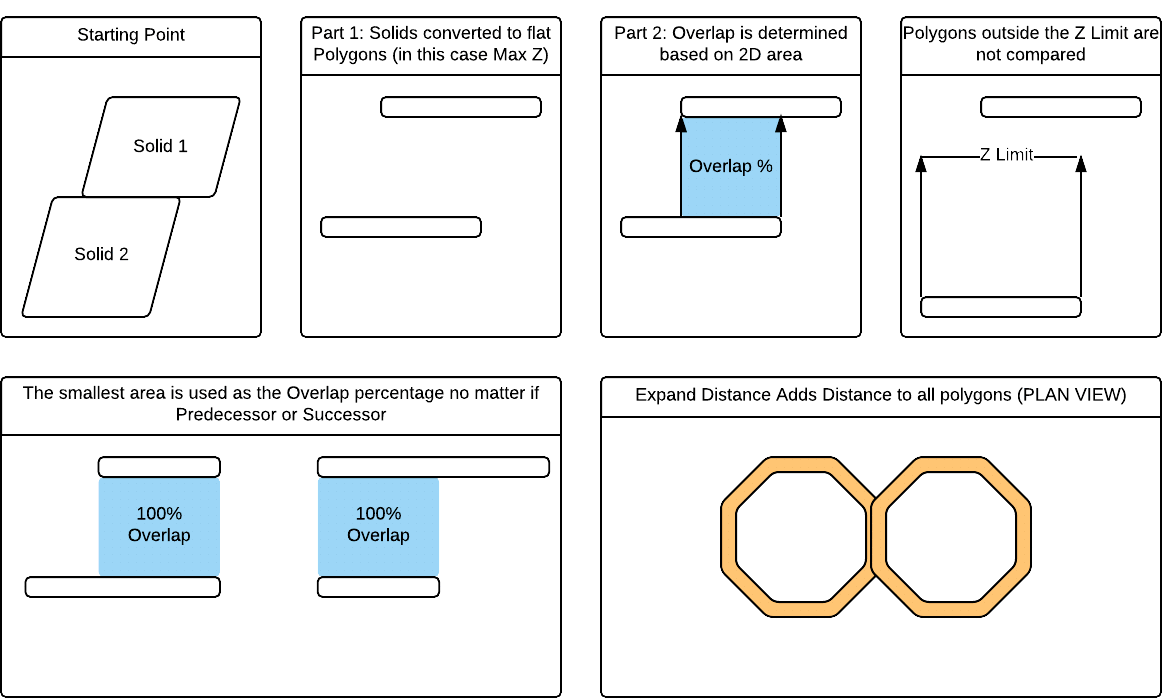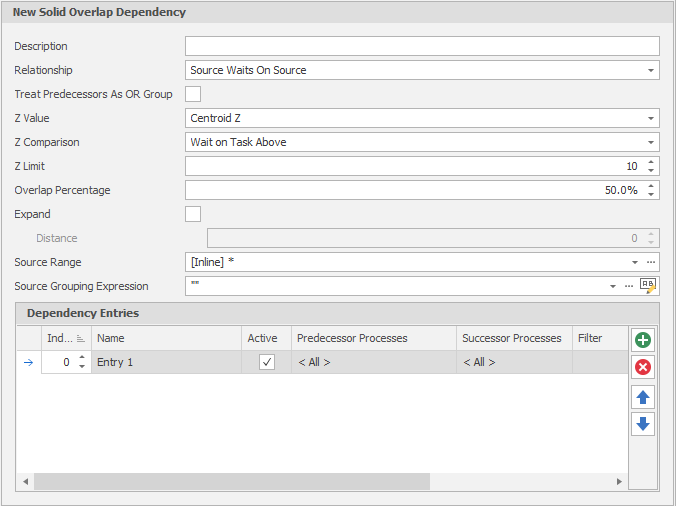Solid Overlap Dependencies 
A Solid Overlap Dependency compares Solids in Plan View looking up, down or both directions based on a certain Overlap Percentage. The lower the Overlap Percentage the more likely a Dependency will be created. The Expand Option will look further around the Solid and Grouping Expressions are used to improve performance by limiting the number of comparisons required.

Solid Overlap Dependencies Conceptual Diagrams
When you add or edit a Dependency of this type, you can set the following parameters (or accept the defaults where applicable):
Description
Optionally, enter a Description that can be used with the Name to further identify the Dependency. Detail useful for diagnosing issues with Dependencies should be added here.
Colour
Use the drop-down to differentiate this type of dependency by colour in the Animation Window.
Relationship
The Predecessor to Successor Relationship. Defaults to Source Waits on Source. Source Waits On Destination means a Source Task is waiting on a Destination Task to be finished.
Treat Predecessors as OR Group
Where multiple predecessor tasks have the same successor task and the OR check box is NOT enabled, the successor task will only be released after ALL of the predecessor tasks are completed.
Where multiple predecessor tasks have the same successor task and the OR check box is enabled, then the successor task will be released when ANY of the predecessor tasks are completed.
Z Value
Select a (Centroid Z, Maximum Z, Minimum Z) source for the Z Value used to calculate the solid overlap from polygons.
Z Comparison
Specify a (Wait on Task Above or Wait on Task Below) Z comparison which is used with the specified Z Value and Z Limit to constrain the solid overlap calculation in that direction.
Z Limit
Specify a Z Limit which is used with the Z value to constrain the solid overlap calculation.
Overlap Percentage
Specify an Overlap Percentage. The lower the Overlap Percentage the more likely a Dependency will be created.
Expand Distance
Select this check box to add a Distance to the polygons used in the solid overlap calculation.
Source Range
Set the Source (Text Range or [Inline] *) Range that applies to the Tasks. See: Text Range and Inline Ranges.
Source Grouping Expression
As the name suggests a Grouping Expression creates groups out of various Leaves in your Table. Dependencies are then created INSIDE each Group between the included Tasks (but not BETWEEN Groups). When considering what to include in a Grouping Expression you should think about what attributes are shared and include them in your expression. Conversely, you want to exclude attributes that you want to create interactions between.
Dependency Entries
Use the local toolbar to add Dependency Entries. Copy, Insert Copy and Move options are available when you right-click on a Dependency Entry. Other options will depend on the dependency type.![]() Add a new item to the list.
Add a new item to the list.![]() Delete the item(s) currently selected in the list.
Delete the item(s) currently selected in the list.![]() Move the currently selected item(s) Up to reorder the list.
Move the currently selected item(s) Up to reorder the list.![]() Move the currently selected items) Down to reorder the list. Specify the following parameters for each Entry:
Move the currently selected items) Down to reorder the list. Specify the following parameters for each Entry:
Name
The Name used to identify the Dependency Entry in the Snapshot Viewer.
Active
Use the Active check box to toggle the inclusion/exclusion of the Entry in the Schedule.
Predecessor/Successor Processes
Allows you to control which Processes are used for the Dependency.
Release Delay
Once a Predecessor Range has been completed, the Release Delay controls how long until the Successor Range is considered "Released" and can be worked. Accept the default (None) or build a Release Delay Expression using the operators, constants and functions provided by the Expression Editor.
Description
Optionally, enter a Description that can be used with the Name to further identify the Dependency Entry.
